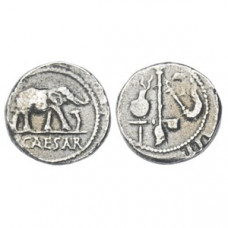Reproduction Denarius of Julius Caesar - Elephant
Obverse: Elephant walking right, trampling on horned serpent. CAESAR in exergue.
Reverse: Depictions of symbols associated with the office of Pontifex Maximus (chief priest), which Caesar held. These include a simpulum (a ladle used in sacrifices), an aspergillum (a sprinkler), a securis with a wolf’s head at the top (a ceremonial axe), and a culullus (a type of jug).
History: The original coin was minted between 49-48 BC and was the first coin struck in the name of Julius Caesar, and one of the first to bear the name of a living Roman.
All of Caesar's military expeditions were costly ventures, and the Civil War (49-45) was no exception. To pay his troops, who had been promised substantial payment for their fidelity and sacrifice, Caesar set about minting the so-called 'elephant denarii'. These coins possess huge historical importance as they were minted by Caesar to pay his troops, to fight the Civil War against Pompey that led to the collapse of the Roman Republic and the establishment of the Roman Empire.
An elephant is depicted on the obverse, approaching a serpent at full tilt, on the cusp of trampling it. The Romans regarded these two animals as eternal foes. By assuming the form of the dominant and noble elephant, and portraying Pompey as the serpent, Caesar was bolstering his claim to rightful authority.
The items on the reverse feature various priestly implements to signify Caesar's role as Pontifex Maximus, emphasising his religious authority and his position within Roman society not just as a military leader but also as a significant religious figure.
Date: Military mint traveling with Caesar Circa 49-48 BC
Diameter: 1.8cm
Tags: Denarius, Julius Caesar, Elephant, Serpent, Simpulum, Sprinkler, Hat, Travelling Mint, Roman, Reproduction, Replica, Coin




